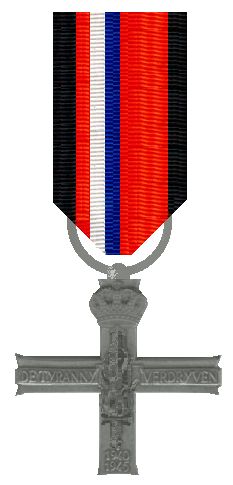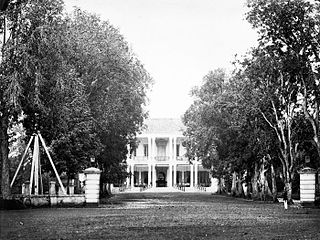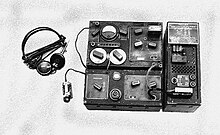De Grootste Nederlander was a public poll held in 2004 by the broadcasting company KRO of the Publieke Omroep. The series has the BBC's 100 Greatest Britons TV format. During the series, it included individual programmes on the top ten, with viewers having further opportunities to vote after each programme.

The Hague School is a group of artists who lived and worked in The Hague between 1860 and 1890. Their work was heavily influenced by the realist painters of the French Barbizon school. The painters of the Hague school generally made use of relatively somber colors, which is why the Hague School is sometimes called the Gray School.

The Rijksakademie van beeldende kunsten was founded in 1870 in Amsterdam. It is a classical academy, a place where philosophers, academics and artists meet to test and exchange ideas and knowledge. The school supports visual artists with a two-year curriculum.

The Resistance Memorial Cross or Resistance Commemorative Cross is a medal awarded in the Netherlands to members of the Dutch resistance during the Second World War.

The Eerste Schilderijenzaal, or Painting Gallery I, is one of two art gallery rooms in Teylers Museum and is the oldest art gallery for contemporary Dutch art in the Netherlands. It was built onto the back of Teylers Oval Room in 1838. It was the young museum's first exhibition space for paintings and could be entered through the Oval Room, which was itself located behind the Fundatiehuis, the former home of Pieter Teyler van der Hulst.

The Great Theatre of Dutch Painters and Paintresses, or De groote schouburgh der Nederlantsche konstschilders en schilderessen, as it was originally known in Dutch, is a series of artist biographies with engraved portraits written by the 18th-century painter Arnold Houbraken. It was published in three volumes as a sequel to Karel van Mander's own list of biographies known as the Schilder-boeck. The first volume appeared in 1718, and was followed by the second volume in 1719, the year Houbraken died. The third and last volume was published posthumously by Houbraken's wife and children in 1721. This work is considered to be a very important source of information on 17th-century artists of the Netherlands. The Schouburg is listed as one of the thousand most important works in the Canon of Dutch Literature from the Middle Ages to the present day.
The Dutch Prix de Rome is based on the originally French Prix de Rome and is awarded annually to architects and artists younger than 35. The award was initiated in 1807 by Louis Bonaparte, then ruler of the Kingdom of Holland, and confirmed after independence by William I of the Netherlands. It was canceled in 1851 by the statesman Johan Rudolph Thorbecke and reinstated in 1870 by William III of the Netherlands. Since then the winners are selected by the Rijksakademie in Amsterdam.

The Erebegraafplaats Bloemendaal, or Dutch Honorary Cemetery Bloemendaal, is a World War II final resting place in Zuid-Kennemerland National Park in Bloemendaal, Netherlands. Located on the top of a dune, it can be reached by a small path from a parking lot located near the provincial route between Overveen center and Zandvoort.

Oud Eik en Duinen is a cemetery in The Hague, the Netherlands, formerly called Eik en Duinen and also nicknamed "the Dutch Père-Lachaise". The cemetery is built around a chapel constructed around 1247 by William II of Holland in honor of his father, Floris IV, Count of Holland. This chapel was partially demolished in 1581, and in the 17th century the area was again used as a cemetery. When Eik en Duinen was full, a new cemetery, Nieuw Eykenduynen, was constructed in 1891 across the road, and since then the old cemetery is known as "Old" Eik en Duinen.

The Timor and Dependencies Residency was an administrative subdivision (Residency) of the Dutch East Indies located in the Eastern half of Lesser Sunda Islands east of Lombok, it was separated in 1819 from the Governorate of Moluccas (Gouvernement der Molukken. Its capital was at Kupang.

Onze Kunst van Heden was an exhibition held in the winter of 1939 through 1940 at the Rijksmuseum in Amsterdam. Due to the threat of invasion in the years leading up to World War II, the Netherlands' government stored many items from the Rijksmuseum's permanent collection. The resulting empty gallery space was utilized by contemporary Dutch artists to exhibit and sell their art. It was organized by the director of the Rijksmuseum Frederik Schmidt Degener. The show was open to all artists, with each artist allowed to enter four pieces. 902 artists exhibited 3,200 works of art in 74 rooms and cabinets of the Rijksmuseum.
„De kunstenaar kan in tijden van maatschappelijke benauwenis weinig positiefs doen om rampen af te wenden, maar wel kan hij door mede te helpen nationale uitingen op het eigenaardigst naar voren te brengen het gemeenschapsbesef versterken. Wanneer de belangstelling van het publiek uitgaat naar deze manifestatie, die in zulk een omvang in Holland nog niet gezien is, dan zal menige kunstenaar zich op zijn beurt gesterkt voelen".
"The artist can do little positive in times of social distress to avert disasters, but he can, by helping to bring out national expressions in the most idiosyncratic way, strengthen the sense of community. When the public is interested in this event, which has not yet been seen to such an extent in Holland, many artists will feel strengthened in turn."

Semarang Residency was an administrative subdivision (Residency) of the Dutch East Indies located on the northern coast of Central Java and named after its capital city Semarang. It existed from 1818 to 1942, although its borders were changed many times during that period.

Jan Pietersz Graeff was an Amsterdam regent and cloth wholesaler from the 16th century.











